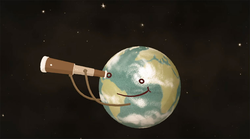| Name | Distance
(ly) | Spectral
type | Mass
(MJ) | Temperature
K (°C) | note | Ref |
|---|
| WISEA 1930−2059 | 30.7+1.5
−1.4 | >Y1 | | 367±79 (94) | Cold and nearby Y-dwarf candidate | [8] [35] |
| WISEU 0503−5648 | 33.2+1.4
−1.3 | >Y1 | | 367±79 (94) | Target for JWST follow-up observations | [8] [36] [35] |
| CWISE J2035–4936 | 265.8±4.9 | M8pec | | | Companion to a red dwarf, underluminous and peculiar spectrum | [37] |
| 2MASS J13173072+4833343 | 127.2±0.3 | M8.5 | 80.2+0.5
−1.8 | | Orbits a white dwarf at 79 au. The white dwarf has an estimated age of about 5.5 Billion years. | [38] |
| CWISE 0738−6643 | 142.2+33.9
−27.4 | esd(?)T5±1.2 | | | candidate extreme subdwarf of spectral type T | [39] |
CW2335+0142
(Gliese 900 b) | 67.97±0.03 | T9 | 10.5 | | Very long orbital separation from its host star (actually a three-star system), 12,000 astronomical units | [40] |
| WISEA 1553+6933 | 125.9+15.0
−13.7 | sdT4±0.5 | | 1076±89 (803) | confirmed subdwarf of spectral type T, might be kinematically extreme | [39] |
| CWISE 2217−1454 | 128.5+31.0
−24.8 | esd(?)T5.5±1.2 | | | candidate extreme subdwarf of spectral type T, potentially most metal-poor T-dwarf from faint H- and Ks-band (strong collision induced absorption) | [39] [41] |
| WISE 1534−1043 | 53.2+4.6
−3.9 | sdY? | | <500 (<227) | Likely first subdwarf of spectral type Y, extreme blue color with Spitzer ch1-ch2, while very red in J-ch2 | [42] |
| HP Draconis C | 260.9±1.6 | | 471.3±31.4 | 7087±205 (6814) | White dwarf, separated by 1140 au from the eclipsing binary HP Draconis | [43] |
| Ross 19 B | 56.9 | T9.5±1.5 | 15 - 40 | 500+115
−100 (227) | Orbits the metal-poor and old (~7.2 Billion years) red dwarf Ross 19 A with a projected distance of 9900 au. The pair has a very low gravitational binding energy, between  and and  ergs, near the theoretical minimum of 1040 ergs for substellar binaries. ergs, near the theoretical minimum of 1040 ergs for substellar binaries. | [44] |
| CWISE 0617+1945 AB | 28.2±5.7 | L2+L4 | | 1853+40
−52 (1580) | nearby brown dwarf binary co-discovered by Backyard Worlds volunteers | [35] [45] |
| 2MASS J22410186-4500298 | 189.2±6.5 | L2 | | | Forms with LEHPM 5005 a co-moving system. LEHPM is reported in the discovery as a possible M-dwarf binary. | [46] |
| BD+60 1417b | 144±13 | L8γ | 10-20 | 1303±74 | Confirmed exoplanet [47] orbiting around a young K0 star, with a projected separation of 1662 astronomical units. | [48] |
| CWISE J052306.42-015355.4 | ≤222 | esdT(?) | | | extreme T subdwarf candidate | [49] |
| CWISE J0146-0508AB | ~130 | L4+L8(blue) | 72±6; 66±10 | 1720±150; 1340±140 | The widest known (as of Feb 2022) brown dwarf binary not in a star cluster or stellar association. The pair has a projected separation of 129 astronomical units. | [50] |
| CWISE J0506+0738 | 104 | L8γ-T0γ | 7 ± 2 | 1140 ± 80 | Candidate of the Beta Pictoris Moving Group. Very red near-infrared colors. | [51] |
| W0727−3607 | 111 | L7+T4 | | | Candidate spectroscopic binary, or a single highly variable object | [52] |
| W1036−5144 | 88 | L7+T4 | | | Candidate spectroscopic binary | [52] |
| W1344−7320 | 65 | L7+T7 | | | Candidate spectroscopic binary | [52] |
| W1055+5443 | 19.5-26 | Y0pec | 4–6 | 500±150 | Bluest Spitzer colors among spectroscopically confirmed Y-dwarfs. Discovered by Caselden (BYW, CatWISE), Goodman (BYW) and Kirkpatrick (CatWISE) [35] | [53] |
| J1249+36 | | sdL | 83–88 | | hypervelocity star with a low mass, moving at a high speed (initially estimated to be 600 km/s) | [54] [55] |
| CWISE J1848−8757 | 29 | young L? | | | CatWISE team discovery, but also independently discovered by two BYW citizen scientists. Red J-W2 color, possibly young L-dwarf | [56] |
| UPM J1040-3551 A+Ba+Bb | 82 | M4+T7+T8 | 246 + (11.5–34.6) + (9.4–28.3) | 3200 ±50 (UPM J1040-3551A) | Young T-dwarfs, likely unresolved spectroscopic binary orbiting an M dwarf, with the less massive object having possibly planetary-mass | [30] [32] |






